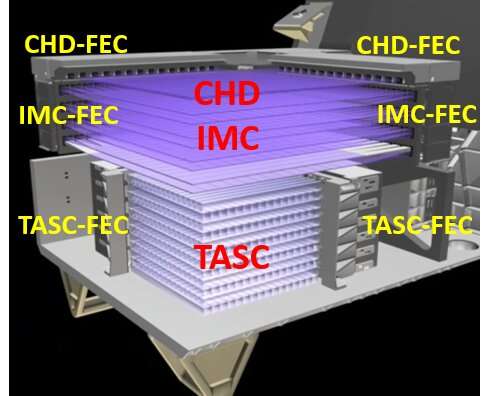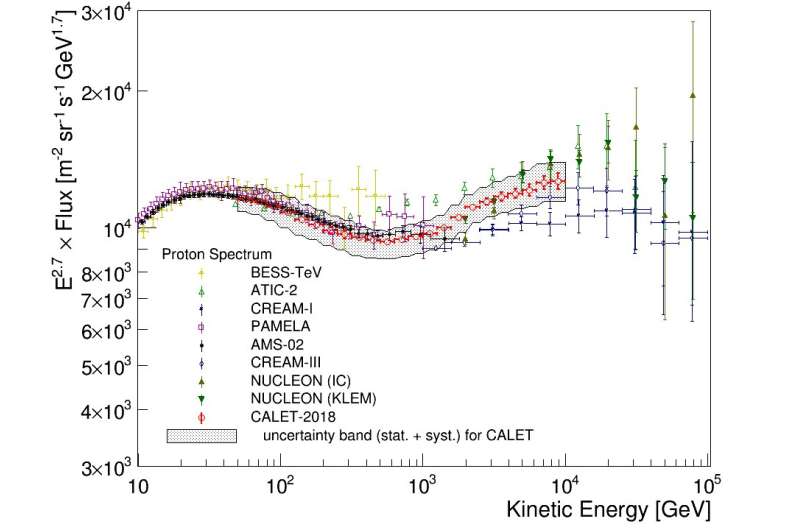May 27, 2019 feature
Direct measurement of the cosmic-ray proton spectrum with the CALET on the ISS

Recent advances in the observation of high-energy radiations, including X-rays and gamma-rays, have unveiled many high-energy aspects of the universe. To achieve a complete understanding of these radiations, however, researchers need to find out more about the high-energy particles (i.e. cosmic rays) that produce them. In fact, non-thermal radiations characterized by the power-law spectrum are all backed by the acceleration and propagation of these rays.
A direct observation of these cosmic rays can only be achieved by placing measuring instruments above all, or most, of the Earth's atmosphere. In addition, as these highest-energy particles are quite rare, studying them requires significantly long observation times. The International Space Station (ISS) is thus an ideal location to collect these observations.
The CALET collaboration, a large team of researchers from several renowned universities worldwide, has developed an instrument that can identify high-energy particles (e.g. electrons, protons and other atomic nuclei) and accurately measure their energy. They then placed this instrument on the ISS and used it to collect a direct measurement of the cosmic-ray proton spectrum. In a recent paper published in Physical Review Letters, the researchers presented the analysis and results of their measurements.
"In order to observe cosmic rays, especially galactic cosmic rays, it is necessary to detect them at high altitude where the remaining atmosphere is sufficiently thin," the CALET collaboration told Phys.org, via email. "For this purpose, many instruments are designed and flown to carry out direct observations for years. As a result, we now have a standard picture of galactic cosmic rays and know that cosmic rays are accelerated by the shock waves in supernova remnants, propagate diffusively through the irregularity of galactic magnetic field, and finally escape from our Galaxy."
Since the beginning of the 21st century, researchers have made significant progress in the observation of cosmic rays using particle-detection techniques developed in collider experiments. Over the past decades, space experiments that leverage Earth's lack of atmosphere have also suggested the occurrence of an unexpected spectral hardening in cosmic rays such as protons, contradicting previous single power-law spectrum predictions. Researchers have proposed several theoretical models to explain this observed spectral hardening, which are still actively debated upon.
The calorimetric electron telescope (CALET) created by the CALET collaboration is a space-based instrument optimized to measure the all-electron spectrum and equipped with a fully active calorimeter. Their instrument can measure the main components of cosmic rays, including protons, light and heavy nuclei in the energy range up to 1 PeV.

"CALET was optimized for measurement of cosmic-ray electrons, but is also beautifully capable of identifying other charged particles: protons (which are hydrogen nuclei), helium nuclei, and nuclei of heavier elements," the CALET collaboration explained.
CALET is made up of three detector systems, each composed of various types of scintillators that emit a pulse of light when penetrated by a charged particle. The charge detector (CHD) at its top can identify the charge of the incident particle (i.e. 1 for electrons and protons, 2 for helium nuclei, etc.), while an imaging calorimeter (IMC) supplements the charge measurement of the CHD, identifies the trajectory of the particle and starts measuring its energy. The final component of CALET is a total absorption scintillating calorimeter (TASC); a very thick [26.4cm] stack of high-density scintillators (lead tungstate) that is thick enough to contain the entire shower of particles initiated by interaction of the particle with thin layers of tungsten interspersed between scintillators in the IMC. The TASC component is thicker than any previously developed space-based calorimeter, which gives CALET an unprecedented precision and range of energy measurement.
CALET was officially launched back in August 19, 2015 and installed on the Japanese Experiment Module-Exposed Facility on the ISS, with an expected mission duration of five or more years. The researchers' scientific observations began a few months later, on October 13, and continuous operations have been carried out since.
"Our data analysis consists of detector calibration, event reconstruction, proton-candidate selection based on the charge and other quantities, estimation of remaining contamination and its subtraction, energy unfolding considering the detector response and the detection-
efficiency correction," the CALET collaboration explained. "Detailed assessment of systematic uncertainties including the tune up and the validation of the Monte Carlo simulation using the beam test results at CERN-SPS is another key point in this analysis."
The recent results published by the researchers are based on flight data up to August 31, 2018. The fully calibrated and reconstructed dataset they collected, dubbed 'level 2," amounted to more than 30 TB, yet the resultant proton spectrum was merely a few kB of it. The CALET space instrument enabled the measurement of the cosmic-ray proton spectrum from 50 GeV to 10 TeV covering, for the very first time, the whole energy interval that was previously investigated in separate sub-ranges using different magnetic spectrometers (e.g. BESS-TeV, PAMELA, and AMS-02) and calorimetric instruments (e.g. ATIC, CREAM, and NUCLEON), with a single instrument.

"CALET has provided a precise measurement of the cosmic-ray proton energy spectrum over a wider range of energies than from any previously published results from other instruments," the researchers said. "CALET's results agree with prior measurements at lower energies, and extend those measurements to higher energies."
Using CALET, the researchers were able to finally establish that the intensity of protons at higher energies is significantly greater than would be expected from a simple extrapolation of the intensity spectrum from lower energies, which had already been suggested by earlier measurements. This 'hardening' of the high-energy proton spectrum demands an alteration of earlier methods of cosmic-ray production and propagation through our galaxy.
"CALET provides an accurate direct measurement of the cosmic-ray proton spectrum in a wide energy range from 50 GeV to 10 TeV showing progressive hardening in the TeV region, thereby severely constraining current models of acceleration and propagation of galactic cosmic rays discussing the generally observed hardening of nuclei spectra," the researchers explained. "The CALET measurement helps to draw a coherent experimental picture, overcoming the long standing issue of connecting the precise measurements performed by magnetic spectrometers below about 1 TeV, with calorimetric measurements performed by balloon experiments at supra-TeV energies. We think this could be considered as one of the highlights in the history of proton-spectrum measurements."
In addition to confirming the existence of spectral hardening, the measurements collected by the CALET collaboration could inform calculations used in indirect searches for dark matter, atmospheric and cosmogenic neutrinos, as well as gamma-ray physics. The researchers are now planning to test a further hypothesis related to a possible charge-dependent cutoff in the nuclei spectra, which would explain the "knee" observed in the all-particle spectrum. This hypothesis can only be tested directly with measurements collected in space experiments of a significant duration, with significant exposure and with the ability to identify individual elements based on charge measurements.
"The acceleration limit of supernova remnants calculated with standard parameters is typically found to be far smaller than the energy of the 'knee,' as observed indirectly by ground detectors," the researchers explained. "Therefore, precise direct observation of the proton and helium spectra at high energy is highly important. Improved statistics and better understanding of the instrument based on the analysis of additional flight data during the ongoing five years (or more) of observations might reveal a charge dependent energy cutoff possibly due to the acceleration limit in supernova remnants in proton and helium spectra, or set important constraints on the acceleration models."
More information: O. Adriani et al. Direct Measurement of the Cosmic-Ray Proton Spectrum from 50 GeV to 10 TeV with the Calorimetric Electron Telescope on the International Space Station, Physical Review Letters (2019). DOI: 10.1103/PhysRevLett.122.181102
Journal information: Physical Review Letters
© 2019 Science X Network



















